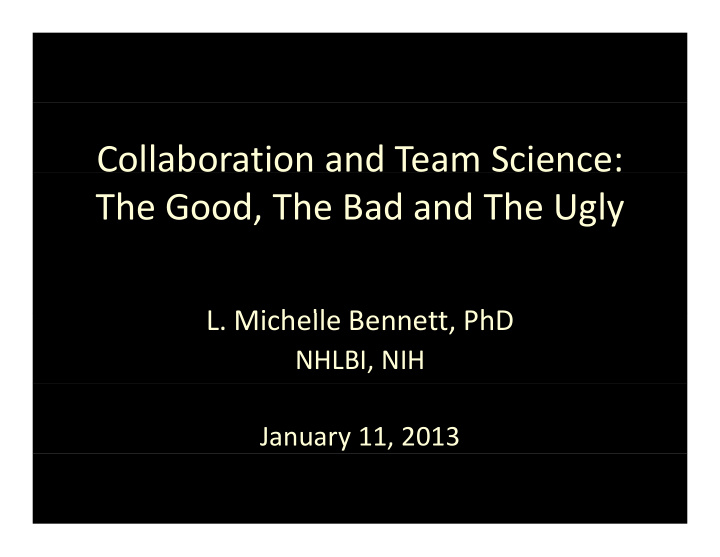



Collaboration and Team Science: The Good, The Bad and The Ugly L. Michelle Bennett, PhD L Mi h ll B tt PhD NHLBI, NIH January 11, 2013
Setting Scientific Teams Up g p For Success L. Michelle Bennett, PhD L Mi h ll B tt PhD NHLBI, NIH January 11, 2013
Collaboration and Team Science • Interested in: ▫ Understanding what makes great ▫ Understanding what makes great collaborations and teams successful ▫ Sharing those elements that contribute to successful ib f l participation in and leadership of collaborations and multidisciplinary research teams ▫ Conflict and how to resolve it Conflict and how to resolve it ▫ Implementing strategies for avoiding conflict teamscience.nih.gov
Clear Vision Power P Trust T t The Science Sharing Sharing I Institutional tit ti l Credit and Support Resources Funding Communication
Model of Team Development Adjourning and T Transforming f i Forming Performing g Storming g N Norming i 5 Bruce Tuckman, 1965, 1977
Collaboration Introduces Threats High Interaction Group ‐ and Integration Identity Multiple Inter ‐ dependent Leaders dependent Leaders Status Status Power Autonomy Self ‐ Identity Independent Independent Interdependent Interdependent 6
Managing the Threats Managing the Threats • Sharing Reagents, Data, Resources Sharing Reagents, Data, Resources • Sharing Credit (papers, media, presentations,…) • Communicating (logistics, meetings, ….) C i ti (l i ti ti ) • Team Dynamics • Recognition and Reward (esp. tenure track) • Power (status, ego, …) o e (s tus, eg , ) ta o
Trust Trust
Types of Trust • Calculus based trust – built on calculations of the relative rewards for trusting or losses for not trusting • Competence based trust – built on the confidence in people’s skills and abilities, allowing them to make decisions and train others • Identity based trust – built on an assumption of perceived compatibility of values, common goals, emotional/intellectual connection
Building a Team Building a Team • Teams can be formed: T b f d – Top down – Bottom up • Key to success? – Top ‐ Down Support T D S t
Storming is Important Adjourning and Threats: Threats: Transforming T f i Forming • Power • Status • Autonomy Performing g Storming g Challenges: • trust, personality styles, style under stress, style in conflict, style in conflict N Norming i competition for power, autonomy, status, language, culture, and poor listening poor listening 11 Bruce Tuckman, 1965, 1977
Shared Vision Shared Vision
Setting Expectations Provides a scaffold for building deeper trust There are no secrets or surprises and there is a i d th i strong platform for discussion discussion
“Last year, this journal received an unusual request: could three authors have it indicated in a footnote that they were joint second authors on a paper? We refused ” paper? We refused… ‐ Nature Editorial, Jan 2 2013 Nature Editorial, Jan 2 2013
Getting and Sharing Credit g g • What is the #1 issue that • What is the #1 issue that causes causes problems in a collaborative research effort?
Communicating • Who is Leading? Co ‐ Leading? • When are we meeting? How frequently? • Format of meetings and expectations • Accountability – what if someone doesn’t deliver? • Logistics – who is responsible? • Decision making – how? Who is involved? • Sharing information throughout the team g g • Getting input from all team members • Project management? Scientific Management? ojec a a e e g Sc e c a a e e g
Productive Collision Contain Personal Conflict Share Perspectives & Share Perspectives & Invite Disagreement
Conflict Management Conflict Management What will happen if there is a disagreement? disagr eemen t? There will be disagreements….. There will be disagreements…..
Team Dynamics “It’s not the science “It’ t th i yo you need to worry u need to worr y about, it’s the team d dynamics” i ”
Clear Vision Power P Trust T t The Science Sharing Sharing I Institutional tit ti l Credit and Support Resources Funding Communication
Prenuptials for Scientists: Collaborative Research Agreements g Some Categories to cover • Goals of Collaboration Goals of Collaboration Including…when is the project “ over ” ? o • Who Will Do What? Expectations, responsibility and accountability E t ti ibilit d t bilit o Sharing/Storing Reagents and Data • How? When? Where? o Authorship, Credit • Criteria, attribution, public comment, media, IP o Contingencies and Communicating Contingencies and Communicating • • What if …? and Rules of engagement o Conflict of Interest • How will you ID conflicts? And resolve them? o teamscience.nih.gov 21
Participating Shouldn’t be Risky High Risk Low Low Grad Post ‐ doc Tenure Track Early Career Established Student Student Tenured Tenured Career Status 22
Participating Shouldn’t be Risky High Risk Low Low Grad Post ‐ doc Tenure Track Early Career Established Student Student Tenured Tenured Career Status 23
Participating Shouldn’t be Risky High Risk Low Low Grad Post ‐ doc Tenure Track Early Career Established Student Student Tenured Tenured Career Status 24
Can we make participating in team science safe? Great first flight, Son! Don’t worry, Fred will catch you if you fall… 25
Encourage Use of Explicit Agreements Encourage Use of Explicit Agreements • Include participating in or leading an IR project in the offer letter or a pre ‐ tenure agreement – Roles, Responsibilities, Expectations – Review and Reward • Review criteria, sharing credit – Mentoring • For and by the scientist – Joint Appointments • What can everyone expect and how to make changes teamscience.nih.gov 26
Preemptive Approach p pp • Develop scaffolds to establish trust • Written agreements serve as scaffolds – Prenuptial agreements p g – TT offer letters or TT review agreements • Develop policies that support collaboration Develop policies that support collaboration • Provide support (training, education, ADR, etc..) • Instit tional self a areness • Institutional self ‐ awareness
Thank ‐ you Thank you
Recommend
More recommend